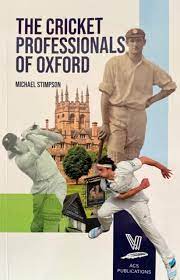The Cricket Professionals of Oxford
Martin Chandler |Published: 2024
Pages: 200
Author: Stimpson, Michael
Publisher: ACS
Rating: 3.5 stars

The dreaming spires of Oxford have provided the backdrop to much good cricket over the years. The county itself has never had First Class status, but the University and its constituent colleges have made sure that the game played a substantial role in the life of the city and its environs.
More than fifty Test cricketers have played for the University and they have come from all over the British Isles and indeed further afield. Famous names like Fry, Warner, Jardine, Cowdrey, Pataudi and Khan have all played in the city. These members of the student population were however amateurs. The subject of this, Michael Stimpson’s second cricket book* looks at their professional brethren, and in scope restricts itself to those born in or having a substantial connection with the city.
The existence of the University and its colleges meant that there have long been plenty of opportunities for men to make a living from cricket, be that playing, coaching, umpiring or maintaining the grounds on which the game was played and supplying the equipment involved. Particularly in the days before the coming of the railways local men were in the best position to take the opportunities, and the first of the men whose story is told in The Cricket Professionals of Oxford, the unlikely sounding Pierre Bancalari, was born as long ago as 1806.
From Bancalari Stimpson looks at more than thirty men who covering the intervening years and, disproportionately, there are as many as seven current cricketers who hail from the city. Four of them, brothers Ben and Luke Charlesworth and Tom and Oliver Price are all at Gloucestershire, but the most interesting is undoubtedly George Munsey who, in an eight year career, has played just four First Class matches, his living being, it would seem, derived entirely from the white ball game.
So what of those in between? Perhaps surprisingly the city has produced only two men capped by England, both Hampshire players. The first is the redoubtable George Brown*, and the second batsman Johnny Arnold who was capped once against New Zealand in 1931. Arnold had a long football career as well with Southampton and then Fulham and, in 1933, played for England in the home international against Scotland to make him the second of only two** men with a single international appearance in each of the two sports.
As an Oxfordshire man himself, and one who played club cricket with and against some of the men featured in the book, Stimpson is ideally qualified to write this book. His familiarity with the territory and personal knowledge of those he features add a depth to his narrative that no amount of research of press and other archives can achieve alone. He also injects into what he writes sufficient social and local history to give context to all that he writes.
Of all the chapters in the book my personal favourite is one of the longest, that concerning Alan Castell, one of those who Stimpson knows and clearly discussed the project with. The name is one I have always known, although I hadn’t realised he was an Oxford man. As a youngster what fascinated me about Castell was the knowledge that he was a leg spinner, very much an endangered species in English cricket in the late 1960s when the only English leg spinner of any note was Robin Hobbs.
Castell I knew had made a good start to his career in the early 1960s, fallen away and then made something of a return before leaving Hampshire and the First Class game at 28 in 1971. What I didn’t know was that latterly he was bowling medium pace seamers, and had left the wrist spin of his youth behind. Nor did I know that, despite his ordinary stats, he could at least claim the greatest cricketer of them all, Garry Sobers, as his rabbit.
The Cricket Professionals of Oxford is a book I much enjoyed and, whilst its approach of looking at cricketers from a specific locality is not quite unique I certainly don’t recall reading anything as thorough before, and I sincerely hope that other towns and cities will get the same treatment in the future from other writers.
*An excellent biography of George Brown that I reviewed here. An all-rounder in the fullest sense of the word Brown scored more than 25,000 runs and took more than 600 wickets with his medium fast bowling. He was selected seven times by England between 1921 and 1923, each time as wicketkeeper!
**Wally Hardinge of Kent and Newcastle, Arsenal and Sheffield United is the other.






Leave a comment